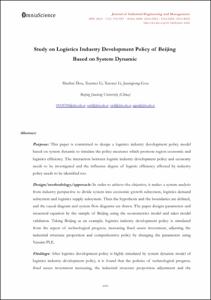Mostra el registre d'ítem simple
Study on logistics industry development policy of Beijing based on system dynamic
| dc.contributor.author | Dou, Shuihai |
| dc.contributor.author | Li, Xuemei Li |
| dc.contributor.author | Li, Xuewei |
| dc.contributor.author | Gou, Juanqiong |
| dc.date.accessioned | 2014-06-10T11:55:37Z |
| dc.date.available | 2014-06-10T11:55:37Z |
| dc.date.issued | 2014-05 |
| dc.identifier.citation | Dou, Shuihai [et al.]. Study on logistics industry development policy of Beijing based on system dynamic. "Journal of Industrial Engineering and Management", Maig 2014, vol. 7, núm. 2, p. 573-587. |
| dc.identifier.issn | 2013-0953 |
| dc.identifier.uri | http://hdl.handle.net/2099/14828 |
| dc.description.abstract | Purpose: This paper is committed to design a logistics industry development policy model based on system dynamic to simulate the policy measures which promote region economic and logistics efficiency. The interaction between logistic industry development policy and economy needs to be investigated and the influence degree of logistic efficiency affected by industry policy needs to be identified too. Design/methodology/approach: In order to achieve the objective, it makes a system analysis from industry perspective to divide system into economic growth subsystem, logistics demand subsystem and logistics supply subsystem. Then the hypothesis and the boundaries are defined, and the causal diagram and system flow diagrams are drawn. The paper designs parameters and structural equation by the sample of Beijing using the econometrics model and takes model validation. Taking Beijing as an example, logistics industry development policy is simulated from the aspect of technological progress, increasing fixed assets investment, adjusting the industrial structure proportion and comprehensive policy by changing the parameters using Vensim-PLE. Findings?After logistics development policy is highly simulated by system dynamic model of logistics industry development policy, it is found that the policies of technological progress, fixed assets investment increasing, the industrial structure proportion adjustment and the comprehensive policy have different function to affect GDP, logistics demand, supply capacity and actual logistics costs. Originality/value: Compared with the previous research, this paper analyzes the interactive mechanism between logistics industry policy and region economy from a system perspective and establishes system dynamics model of logistics industry development policy to make up for the limitation of previous research. |
| dc.format.extent | 15 p. |
| dc.language.iso | eng |
| dc.publisher | OmniaScience |
| dc.rights | Attribution-NonCommercial 3.0 Spain |
| dc.rights.uri | http://creativecommons.org/licenses/by-nc/3.0/es/ |
| dc.subject | Àrees temàtiques de la UPC::Economia i organització d'empreses::Direcció d'operacions::Modelització de transports i logística |
| dc.subject.lcsh | Business logistics -- Beijing (China) -- Mathematical models |
| dc.subject.other | Logistics Industry |
| dc.subject.other | System Dynamics |
| dc.subject.other | Regional Economy |
| dc.subject.other | Policy Proposal |
| dc.title | Study on logistics industry development policy of Beijing based on system dynamic |
| dc.type | Article |
| dc.subject.lemac | Logística (Indústria) -- Pequín (Xina) -- Models matemàtics |
| dc.identifier.dl | B-28744-2008 |
| dc.description.peerreviewed | Peer Reviewed |
| dc.rights.access | Open Access |
| local.citation.author | Dou, Shuihai; Li, Xuemei Li; Li, Xuewei; Gou, Juanqiong |
| local.citation.publicationName | Journal of Industrial Engineering and Management |
| local.citation.volume | 7 |
| local.citation.number | 2 |
| local.citation.startingPage | 573 |
| local.citation.endingPage | 587 |
Fitxers d'aquest items
Aquest ítem apareix a les col·leccions següents
-
2014, vol. 7, núm. 2 [15]
Special Issue – LISS 2013


